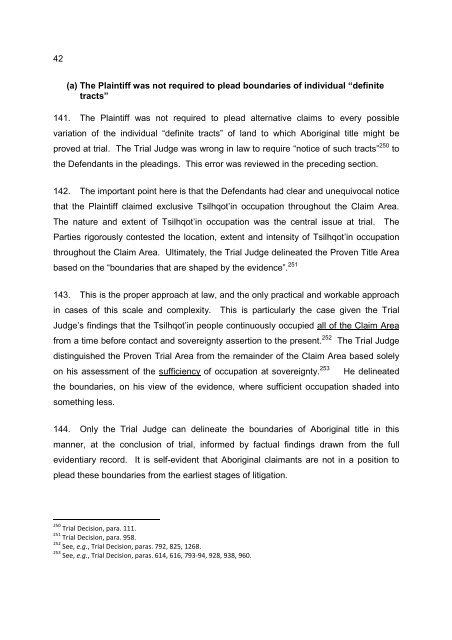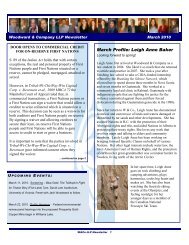Appellants factum - Woodward & Company
Appellants factum - Woodward & Company
Appellants factum - Woodward & Company
Create successful ePaper yourself
Turn your PDF publications into a flip-book with our unique Google optimized e-Paper software.
42(a) The Plaintiff was not required to plead boundaries of individual “definitetracts”141. The Plaintiff was not required to plead alternative claims to every possiblevariation of the individual “definite tracts” of land to which Aboriginal title might beproved at trial. The Trial Judge was wrong in law to require “notice of such tracts” 250 tothe Defendants in the pleadings. This error was reviewed in the preceding section.142. The important point here is that the Defendants had clear and unequivocal noticethat the Plaintiff claimed exclusive Tsilhqot’in occupation throughout the Claim Area.The nature and extent of Tsilhqot’in occupation was the central issue at trial. TheParties rigorously contested the location, extent and intensity of Tsilhqot’in occupationthroughout the Claim Area. Ultimately, the Trial Judge delineated the Proven Title Areabased on the “boundaries that are shaped by the evidence”. 251143. This is the proper approach at law, and the only practical and workable approachin cases of this scale and complexity. This is particularly the case given the TrialJudge’s findings that the Tsilhqot’in people continuously occupied all of the Claim Areafrom a time before contact and sovereignty assertion to the present. 252 The Trial Judgedistinguished the Proven Trial Area from the remainder of the Claim Area based solelyon his assessment of the sufficiency of occupation at sovereignty. 253 He delineatedthe boundaries, on his view of the evidence, where sufficient occupation shaded intosomething less.144. Only the Trial Judge can delineate the boundaries of Aboriginal title in thismanner, at the conclusion of trial, informed by factual findings drawn from the fullevidentiary record. It is self-evident that Aboriginal claimants are not in a position toplead these boundaries from the earliest stages of litigation.250 Trial Decision, para. 111.251 Trial Decision, para. 958.252 See, e.g., Trial Decision, paras. 792, 825, 1268.253 See, e.g., Trial Decision, paras. 614, 616, 793-94, 928, 938, 960.



